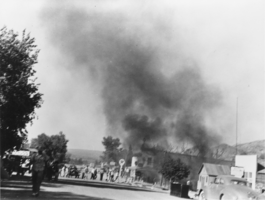Search the Special Collections and Archives Portal
Search Results

Main Street of Beatty School in Nevada: photographic print
Date
Archival Collection
Description
From the Nye County, Nevada Photograph Collection (PH-00221) -- Series III. Beatty, Nevada -- Subseries III.F. Palsgrove Family
Image

Postcard showing a bus stopped at Andre's Grocery Store and Fountain near the Exchange Hotel, Main Street, Beatty, Nevada: photographic print
Date
Archival Collection
Description
From the Nye County, Nevada Photograph Collection (PH-00221) -- Series III. Beatty, Nevada -- Subseries III.F. Palsgrove Family
Image
Mummified remains of a Native American known as Queho: photographic print
Date
Archival Collection
Description
From the Nye County, Nevada Photograph Collection (PH-00221) -- Series IV. Pahrump, Nevada -- Subseries IV.D. Wiley Family. Mummified remains of an Indian renegade known as Queho. Many years previous to when this photo was taken in the early 1940, Queho is said to have killed and robbed a number of individuals in the Searchlight, Nevada area. Unsuccessful efforts were made to to apprehend Queho. In the early 1940, the men pictured here on the left and right were exploring an area along the Colorado River when they saw a cave in the cliffs above the river. They climbed up to the cave and Queho's remains were found. Research established that the remains were Queho’s because several of the artifacts he had stolen from people in Searchlight accompanied the remains. Queho’s remains were turned over to the Palm Mortuary in Las Vegas when a question arose there as to who would pay for the expenses of keeping Queho there and his burial. Roland Wiley, district attorney for Clark County, Nevada, at that time, suggested that the remains be turned over to the Elks Lodge, where for a number of years they were exhibited on the Helldorado grounds during Helldorado Days in a glass display case with some of the stolen artifacts. Queho’s remains were stolen from the Elks on two occasions, and each time they were recovered. Jim Cashman, head of the Las Vegas Elks at that time, grew tired of worrying about the theft of Queho’s remains, so they moved to a building belonging to Dobie Doc Caudill near the Tropicana Hotel. Roland Wiley purchased Queho’s remains from Dobie Doc for $100 and buried them near Cathedral Canyon, located on Wiley’s ranch in Pahrump Valley overlooking his Hidden Hills airstrip, in concrete and steel so they could not be easily stolen again. Wiley believed the Indian deserved a decent burial and buried popcorn with the remains to accompany Queho on his journey. Standing second from the left is Frank Waite, chief of police in Las Vegas for many years. Waite was a member of the posse that initially searched for Queho.
Image

Postcard of Tonopah, Nevada: photographic print
Date
Archival Collection
Description
From the Nye County, Nevada Photograph Collection (PH-00221) -- Series III. Beatty, Nevada -- Subseries III.F. Palsgrove Family. The old high school, now the site of Barsanti Park, is visible in the distance in the distance on the left. The Mizpah shaft, Tonopah's largest producing mine, is in the foreground.
Image

Shrine by Roland Wiley at the Cathedral Canyon, Nevada: photographic print
Date
Archival Collection
Description
From the Nye County, Nevada Photograph Collection (PH-00221) -- Series IV. Pahrump, Nevada -- Subseries IV.D. Wiley Family. A few lights have been strung up and guests have been invited to commemorate the occasion.
Image

Looking north up Main Street at the Gold Ace fire, Nevada: photographic print
Date
Archival Collection
Description
From the Nye County, Nevada Photograph Collection (PH-00221) -- Series III. Beatty, Nevada -- Subseries III.G. Reidhead Family
Image

Looking north up Main Street at the Emergency Medical Clinic, Nevada: photographic print
Date
Archival Collection
Description
From the Nye County, Nevada Photograph Collection (PH-00221) -- Series III. Beatty, Nevada -- Subseries III.G. Reidhead Family. The clinic building was originally the home of Judge Gray. Transcribed from attached note: This building was originally used in Rhyolite, Nevada, as a mercantile store. In 1909 it moved to Pioneer as a general merchandise store. Then in 1911 it was moved to Transvaal. In 1918 it moved to Beatty. In the 1930s-40s it was the residence and office of Judge William B. Gray. In about 1975-6 it moved back to Rhyolite by Evan Thompson. It is still there, next to the Bottle House -- Claudia Reidhead, 8/97.
Image

Labor Day Parade in Beatty, Nevada: photographic print
Date
Archival Collection
Description
From the Nye County, Nevada Photograph Collection (PH-00221) -- Series III. Beatty, Nevada -- Subseries III.G. Reidhead Family
Image

Looking south down Main Street toward Daylight Pass, Beatty, Nevada: photographic print
Date
Archival Collection
Description
From the Nye County, Nevada Photograph Collection (PH-00221) -- Series III. Beatty, Nevada -- Subseries III.G. Reidhead Family. The stone building is the Episcopal Church; Judge Gray's home is visible on the same side of the street as the church.
Image

Tonopah and Tidewater Railroad cars: photographic print
Date
Archival Collection
Description
From the Nye County, Nevada Photograph Collection (PH-00221) -- Series III. Beatty, Nevada -- Subseries III.G. Reidhead Family
Image
